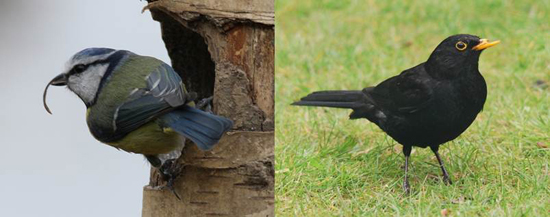Types of deformities
The types of beak deformities experienced by birds in British and Irish gardens are quite wide ranging. For ease of comparison, we have classified each Big Garden Beak Watch record according to the principal beak abnormality exhibited. For the four species for which we have the most number of records – Blue Tit, Blackbird, Starling and Great Tit – we have been able to compare the frequency of the principal beak deformities experienced.
When considering sightings of all species, overgrown upper mandibles have been logged most often, followed by both mandibles over grown and then by crossed mandibles. However, pooling all Big Garden Beak Watch records together in this way means that fascinating between-species differences in the frequency of different beak abnormality types are obscured.
|
Deformity type |
All species |
Blue Tit |
Blackbird |
Starling |
Great Tit |
|
Both mandibles overgrown |
202 |
92 |
10 |
36 |
26 |
|
Crossed mandibles |
146 |
55 |
24 |
2 |
10 |
|
Fractured beak |
67 |
3 |
45 |
0 |
0 |
|
Gap between closed mandibles |
32 |
1 |
19 |
1 |
1 |
|
Lateral curvature |
31 |
2 |
14 |
2 |
0 |
|
Lower mandible overgrown |
93 |
26 |
19 |
9 |
2 |
|
Other type |
26 |
2 |
5 |
0 |
2 |
|
Upper mandible overgrown |
261 |
118 |
31 |
18 |
22 |
In general, the deformities experienced by Blue Tits relate to their beaks being overgrown. Over half of beak deformities in Starlings involve both mandibles becoming elongated, and this deformity is also that which is most frequently observed in Great Tits. There are no records of fractured beaks in Blue Tits, Starlings or Great Tits. In contrast, the most regularly observed beak deformity of Blackbirds is where individuals have seemingly fractured their beaks. Why is this happening? Are Blackbirds colliding with hard surfaces, like windows? Are their beaks being weakened in some way? Currently, we just don’t know.
Reasons for these apparent between-species differences are unclear and require attention. You can help by telling us about any birds that you have ever seen in your garden with a deformed beak.







Share this page